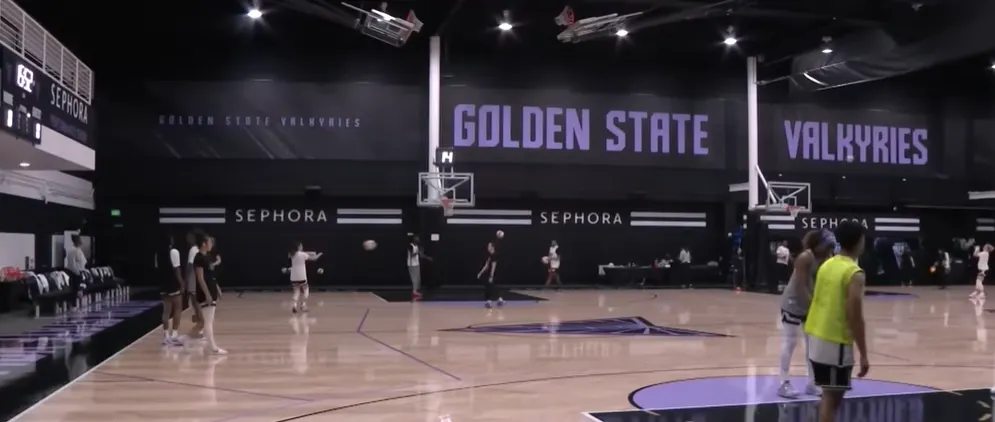There were purple-dyed ponytails, sequined fans, and fireworks shooting through the rafters- it was as though the WNBA had finally found its niche as far as the Bay Area was concerned. The entry of the Golden State Valkyries was not just another expansion, but it is like a cultural awakening.
The streets recalled Longing: to the station called the Ballhalla.
Fans in the Bay Area had long travelled east to Sacramento to soak up encounters with the WNBA. After decades of anticipation, the Chase Center, also known as Ballhalla, with its Norse mythology-based decor and fixtures, and the court of violet and gold, was lit.
In the same arena, on opening night, Valkyries had a sellout of more than 18,000 people, fans of all ages, races, and sexes in support of their new team. As we can see, this was never an ordinary basketball team, but an indicator of affiliation.
Humble Start, Sky-High Expectations
Launched quietly in 2023 and roaring to life in 2025, the Valkyries were the WNBA’s first expansion team in 17 years. Thanks to forward-thinking leadership fronted by President Jess Smith, GM Ohemaa Nyanin, and coach Natalie Nakase, they assembled talent fast and smart.
Season-ticket sales soared past 10,000, and the franchise’s valuation rocketed to $500 million, the highest in WNBA history. Courtside seats? They fetched up to $3,900. But Smith made it clear: growth wouldn’t come at the expense of accessibility, promising community-oriented pricing alongside luxury packages.
Proving Doubters Wrong Game by Game
Critics questioned whether a team without one big-name star could endure. The Valkyries answered with unity, grit, and moments of brilliance.
Rookie standout Veronica Burton exploded onto the scene with a 30-point, 7-rebound, 7-assist masterpiece, joining an elite 30/7/7 club in WNBA lore.
A dominant 90–59 win over the Chicago Sky set a new record: the Valkyries became the winningest expansion team in WNBA history with their 18th victory.
Whispers of “best expansion team ever?” echoed from corners of Swish Appeal and beyond. Could this be the Dawn of another dynasty like the Detroit Shock or the Minnesota Lynx?
Champions of Culture and Community
This franchise isn’t just rewriting the court’s history; it’s embedding itself in civic culture.
Fans like a 74-year-old former Sacramento Monarchs devotee made the commute from Silicon Valley because she wouldn’t miss this homecoming for the world. For her and many, this team fulfilled a dream deferred for over 27 years.
And while WNBA expansion often implies logistics, the Valkyries are flipping the script—celebrating culture with local DJs, queer clubs’ music, and art from Bay Area icons like Allison Hueman, showcasing that this team belongs to the place and its people.
Home Court, but Not Safe Court Yet
Even in this triumph, reality bites. A scheduling clash with the Laver Cup, a preexisting tennis event, threatens the Valkyries’ first home playoff game at Chase Center. Now, options like San Jose or Oakland are on the table.
It underlines a hard truth: even as an expansion jewel, the Valkyries still face growing pains and infrastructural inequities not uncommon in women’s sports, even when rapidly succeeding.
Beyond the Present: A Future in Motion
What happens next holds even more transformative potential.
The franchise is already laying foundations for tomorrow, preparing for its first draft pick, Juste Jocyte, a Lithuanian powerhouse who visited Chase Centre recently and will add a global flair to their roster.
Furthermore, the WNBA’s expanding pace (Toronto and Portland by 2026, others to follow) puts the Valkyries in the center of a sweeping conversation about the league’s future, one rooted in equity, growth, and identity.


![It only takes a single, absurd moment to shift the focus in a packed sports arena from strategy to shock. Suddenly, freedom becomes fragile. On WNBA courts in Phoenix, New York, Chicago, and Atlanta, that shock came disguised in fluorescent green sex toys thrown from the stands onto the court. This isn’t a prank anymore, it’s a breaking point. When a Game Gets Interrupted by Absurdity On August 5, during a Phoenix Mercury game against the Connecticut Sun, 18-year-old Kaden Lopez took out a green dildo from his sweater pocket and hurled it into the crowd. Witnesses say it struck a man and his 9-year-old niece, both sitting and watching the flow of the game. The crowd was stunned not just by the impact, but by the intention. Court documents say Lopez called it a “stupid prank trending on social media,” and that he hadn’t intended to hurt anyone. Still, the man and his niece both wanted charges filed because intention doesn’t erase impact. Lopez now faces disorderly conduct, assault, and public display of explicit material charges. Days earlier, at Barclays Center, Charles Burgess, 32, allegedly threw a sex toy that hit a 12-year-old girl. He, too, has been arrested and charged with assault. From Atlanta to Chicago, courts are seeing the same bizarre interruption. The WNBA, arena officials, and fans are staring straight at the uncomfortable truth: something has gone seriously wrong and fast. Beyond Social Media Stunts It’s tempting and enraging to dismiss these incidents as internet-fueled foolishness. But that disregard ignores the real consequences. When players and families pay for a shared experience, this is a violation of safety and respect. Sparks' coach Lynne Roberts refused to laugh it off. “It’s also dangerous,” she said. “This is a family event.” And when Sophie Cunningham, a beloved guard, was nearly struck, she forcefully remarked, “How are we ever going to get taken seriously?” ([turn0search16]) WNBA leadership rightly responded with zero tolerance: fans caught in the act face at least a one-year ban and possible prosecution. Arena staff are ramping up security, keeping a sharper eye on stands for behaviors that escalate beyond cheers and boos. Historical Echoes of Disrespect The WNBA has spent decades fighting for space, both cultural and literal. These games were never supposed to be just a performance; they’ve also been a protest. From the early years when league founders slipped into legitimacy, to today’s stars demanding equity, salaries, and respect, these women have battled narratives inside and outside arenas. So when fans throw objects born from a place meant to demean or sexualize, it's not just reckless; it echoes a history of disrespect toward female athletes. What we’re witnessing isn’t just a bizarre stunt. It’s a regression. Players, Families, and Fans: How the Real Costs Play Out Imagine a mom taking her daughter to a game, teaching her about effort, teamwork, and believing in heroes. Then, in one throw, that lesson collapses, blurred by disrespect and violation. Those struck, like the 9- and 12-year-old girls, aren’t just spectators. They’re learning who is welcome and safe in sports. Each incident chips away at that sense of belonging. The league’s swift statements reinforce that WNBA arenas must be safe havens—places where competitors, families, and young fans learn, cheer, and belong.](https://gotobasketball.com/wp-content/uploads/2025/08/Screenshot-2025-08-21-203647-150x150.webp)


